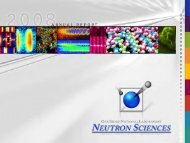ARCS materials - Spallation Neutron Source - Oak Ridge National ...
ARCS materials - Spallation Neutron Source - Oak Ridge National ...
ARCS materials - Spallation Neutron Source - Oak Ridge National ...
Create successful ePaper yourself
Turn your PDF publications into a flip-book with our unique Google optimized e-Paper software.
Energy Transfer (meV)<br />
400<br />
300<br />
200<br />
100<br />
0<br />
0.00 0.20 0.40 0.60 0.80 1.00<br />
Momentum Transfer (c*)<br />
Fig. 5. Spin wave dispersion relation obtained from the triple axis data (lowest<br />
energies) and incident energies of 80, 120, 300, 500, and 700 meV on HET. The line<br />
is a fit to a model for a planar one-dimensional ferromagnet with a zone boundary<br />
magnon energy of 400 meV.<br />
for energies higher than 25 meV FeGe2 behaves as a quasi-one-dimensional<br />
ferromagnet so it is permissible to ignore the variation of Qa with energy<br />
transfer, a fact confirmed by more detailed analysis of these results[16]. By<br />
carrying out measurements with incident energies of 80, 120, 300, 500, and<br />
700 meV we have fully mapped out the c-axis dispersion relation which is<br />
shown in Figure 5. The line is the result of a fit to a planar one-dimensional<br />
ferromagnet model in appropriate in the zero temperature classical limit. The<br />
zone boundary magnon energy is 400 meV, more an order of magnitude larger<br />
than the 25 meV found for the a-axis[14]. This substantial anisotropy reflects<br />
the structure of FeGe2, the Fe-Fe distance in the c-axis chains of Fe spins is<br />
similar to that in pure Fe, whereas in the ab-plane the distance between the<br />
Fe ions is 4.2 ˚A. Along the c-axis the interaction is ferromagnetic and mainly<br />
due to d-orbital overlap while in the basal plane the weaker antiferromagnetic<br />
coupling has its origins in the conduction electrons.<br />
FeGe2 is a unique example of quasi-one-dimensional ferromagnetism in an<br />
itinerant electron system. Studies of the magnetic dynamics at higher temperatures[16]<br />
reveal the presence of well resolved magnon-like excitations even<br />
in the paramagnetic state. The much weaker basal plane coupling drives the<br />
three dimensional ordering, the doping dependence of the ordering wavevector<br />
suggests that this is Fermi surface driven, hole doping by substituting Ga for<br />
Ge increases the incommensurate wavevector similar to the effect of increased<br />
Sr doping in La2−xSrxCuO4 [1] or V doping in CrxV1−x[2]. which are quasi-twodimensional<br />
and three-dimensional realizations of systems which exhibit Fermi<br />
surface driven spin density wave instability. The Fe(Ge1−xGax)2 alloy system<br />
represents another such system which is predominantly one-dimensional magnetically<br />
although the relatively small anisotropy in the resistivity (a factor<br />
of two with higher resistivity along c) indicates the charge carriers are not<br />
restricted to the c-axis.<br />
5

















